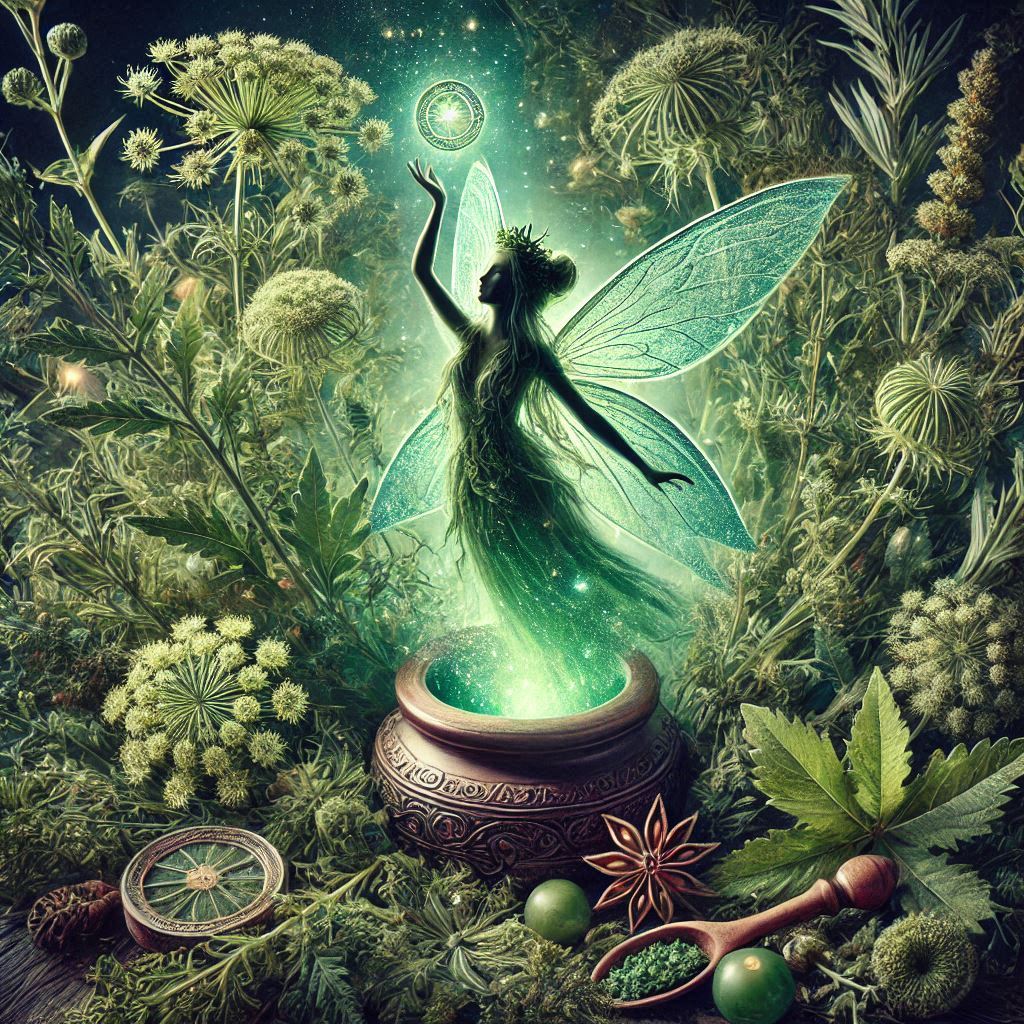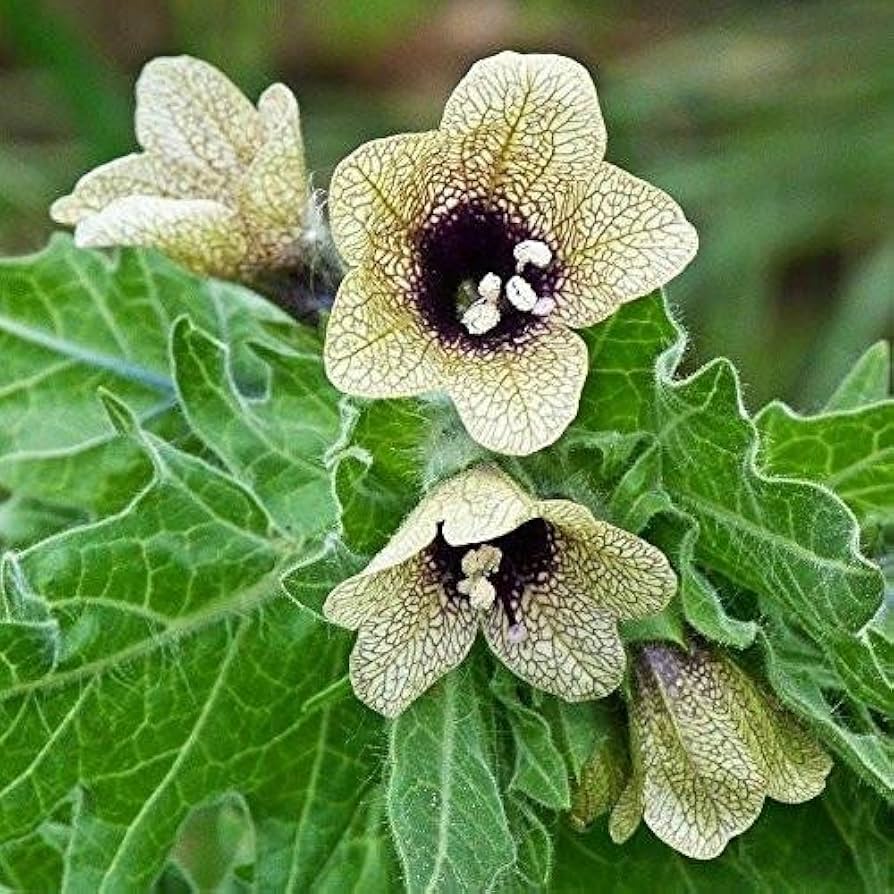Your cart is currently empty!

The Enigmatic Herb: Wormwood
Wormwood, scientifically known as Artemisia absinthium, is a plant steeped in mystery, magic, and medicinal lore. Revered for its bitter taste, potent properties, and mystical reputation, wormwood has been celebrated and feared in equal measure across cultures and centuries. Let us journey through the winding path of this herb’s history, medicinal uses, magical applications, and the ways it has intertwined itself with human life.
A Brief History of Wormwood
Wormwood’s story begins in the cradle of civilization. Ancient texts from Mesopotamia, Egypt, and Greece reference this herb, often associating it with divine power and healing. The name Artemisia honors the Greek goddess Artemis, the patroness of wilderness and protector of women. The herb was believed to carry the goddess’s essence, making it a sacred and powerful plant.
In ancient Egypt, wormwood was used as part of embalming rituals, symbolizing protection and purification. The Greeks employed it to expel intestinal worms (hence its common name) and as a remedy for fevers. Hippocrates, the “father of medicine,” praised wormwood for its diverse therapeutic uses, and Pliny the Elder extolled its virtues as a digestive aid.
During the Middle Ages, wormwood took on a darker reputation. Known for its association with absinthe, the infamous green liqueur, the plant was both lauded for its creativity-inducing effects and demonized for its supposed hallucinogenic properties. Wormwood also found a place in folklore as a talisman against witches and malevolent spirits, often hung in homes or carried in sachets for protection.
By the 19th century, wormwood’s place in history was cemented by its role in absinthe production. The “Green Fairy,” as absinthe was called, became a muse for artists and writers, from Vincent van Gogh to Ernest Hemingway. Though absinthe’s hallucinogenic reputation was later debunked, wormwood’s mystique endures to this day.
Wormwood also held significance in religious and cultural rituals. In some Slavic traditions, it was considered a sacred plant used to purify homes and drive away evil spirits. Early herbalists and alchemists considered wormwood a key ingredient in their concoctions, associating it with transformation and spiritual growth.
Medicinal Uses of Wormwood
Wormwood is not just a plant of legends; it is a treasure trove of medicinal properties. Its primary active compound, thujone, gives the herb its potent effects. However, wormwood must be used with care, as high doses of thujone can be toxic.
Digestive Aid
One of wormwood’s most well-known uses is as a digestive tonic. Its bitterness stimulates bile production, aiding digestion and easing symptoms like bloating, indigestion, and loss of appetite. A traditional wormwood tea can work wonders for sluggish digestion. The herb is often included in bitters formulas, which are popular as aperitifs to stimulate the digestive system before meals.
Antiparasitic Properties
True to its name, wormwood has been used for centuries to expel intestinal worms. Its antiparasitic properties make it a common ingredient in herbal remedies for parasitic infections. Wormwood tinctures and capsules are often combined with other antiparasitic herbs like black walnut and cloves for maximum efficacy. These remedies are particularly valued in traditional medicine systems where parasitic infections are common.
Fever and Pain Relief
In traditional medicine, wormwood has been used as a remedy for fevers and aches. Its anti-inflammatory properties make it helpful for conditions like arthritis and muscle pain. A poultice made with wormwood leaves can be applied to swollen or sore areas for relief. Historical records suggest that wormwood was often used during epidemics as a protective and remedial herb, believed to ward off diseases.
Antimicrobial and Antifungal Effects
Wormwood’s antimicrobial properties make it useful for treating infections. It has been traditionally applied to wounds to prevent infection and used internally to combat bacterial and fungal overgrowth. Modern research supports these uses, indicating that wormwood extracts exhibit significant antimicrobial activity against various pathogens.
Mood and Mental Clarity
While absinthe’s hallucinogenic reputation is largely exaggerated, wormwood does have mild psychoactive effects. It has been used historically to lift the spirits, alleviate melancholy, and enhance focus. Modern herbalists may recommend it in small doses to support mental clarity and reduce anxiety. Wormwood’s ability to promote relaxation and clarity makes it a valuable ally for those dealing with stress and mental fatigue.
Additional Uses in Modern Medicine
In recent years, researchers have explored wormwood’s potential in treating more complex conditions. Some studies suggest that compounds in wormwood may have anti-cancer properties, particularly in targeting specific cancer cells without harming healthy ones. Additionally, wormwood is being investigated for its role in managing autoimmune conditions like Crohn’s disease, where it has shown promise in reducing inflammation and promoting gut health.
Sample Medicinal Recipe: Wormwood Digestive Tea
Ingredients:
- 1 teaspoon dried wormwood leaves
- 1 cup boiling water
- Honey or lemon (optional)
Instructions:
- Place the dried wormwood leaves in a teapot or cup.
- Pour the boiling water over the leaves.
- Let it steep for 5-10 minutes.
- Strain and sweeten with honey or lemon if desired. Sip slowly.
(Note: Limit consumption to one cup daily and avoid prolonged use.)
Magical Uses of Wormwood
Wormwood’s mystical properties are as compelling as its medicinal ones. Often associated with protection, divination, and spirit communication, wormwood has been a staple in magical practices for centuries.
Protection and Banishing
Wormwood is a powerful herb for warding off negativity and malevolent forces. In folklore, it was used to keep evil spirits at bay. Today, it can be burned as incense or placed in sachets to protect a home or person. In some traditions, wormwood was placed at doorways or windows to create a protective barrier, ensuring no harmful entities could enter.
Enhancing Psychic Abilities
Wormwood is known for its ability to open the third eye and enhance psychic vision. It is often used in divination rituals, particularly in conjunction with tools like tarot cards or scrying mirrors. Drinking a mild wormwood tea or using it in incense form can heighten intuition and facilitate communication with the spirit world. When combined with mugwort, another potent herb, its effects on psychic awareness are amplified.
Love and Passion
Wormwood has also been used in love spells and potions. Its intoxicating aroma is believed to kindle passion and attract love. A sachet of wormwood placed under the pillow is said to invite romantic dreams. In some love rituals, wormwood was burned along with rose petals to create a magical smoke that enhanced feelings of desire and connection.
Spirit Work and Ancestral Communication
For those who work with spirits or ancestral energies, wormwood is invaluable. Burned as incense, it can act as a bridge between the physical and spiritual realms, aiding in meditation and seances. Its use should always be approached with respect and intention. In Samhain or Day of the Dead rituals, wormwood may be used to honor the dead and invite their guidance.
Dream Magic and Lucid Dreaming
Wormwood is a favored herb for dream magic. It can be placed under a pillow or burned before sleep to enhance dream recall and induce lucid dreaming. Some practitioners create dream oils by infusing wormwood in carrier oils, which are then anointed on the temples before bedtime.
Sample Magical Recipe: Wormwood Protection Sachet
Ingredients:
- 1 tablespoon dried wormwood
- 1 tablespoon dried lavender
- A pinch of salt
- A small piece of obsidian or black tourmaline
- A small fabric pouch
Instructions:
- Combine the wormwood, lavender, and salt in a bowl.
- Place the mixture into the fabric pouch.
- Add the obsidian or black tourmaline.
- Tie the pouch securely and carry it with you or place it in your home for protection.
Cultivation and Harvesting
For those drawn to wormwood’s magic and medicine, growing the herb can be a rewarding endeavor. Wormwood thrives in well-drained soil and sunny locations. Its silvery-green leaves and aromatic scent make it an attractive addition to any herb garden.
Planting wormwood near vegetable gardens can also serve as a natural pest deterrent, as its aroma repels certain insects. However, it’s important to note that wormwood can inhibit the growth of nearby plants, so it’s best to give it its own space.
Harvest wormwood in the late summer when its essential oils are most potent. The leaves and flowering tops can be dried and stored for later use. Always handle the plant with care, as prolonged skin contact may cause irritation in sensitive individuals. Once dried, the herb can be stored in an airtight container away from direct sunlight for up to a year.
Cautions and Considerations
While wormwood is a powerful ally, it must be used with caution. High doses or prolonged use of wormwood can lead to adverse effects due to its thujone content. Here are some key considerations to keep in mind:
- Toxicity:
Thujone, the active compound in wormwood, can be toxic in large amounts. Overuse may result in symptoms like nausea, dizziness, muscle spasms, and, in severe cases, convulsions. Always follow dosage guidelines and consult with a healthcare professional before using wormwood medicinally. - Pregnancy and Lactation:
Wormwood should be avoided by pregnant or breastfeeding individuals. The herb may stimulate uterine contractions, posing risks during pregnancy. - Allergic Reactions:
Some individuals may experience skin irritation or allergic reactions when handling or consuming wormwood. Always perform a patch test before applying wormwood-infused products to the skin. - Interactions with Medications:
Wormwood may interact with medications, particularly those that affect the liver or nervous system. If you are taking prescription drugs, consult a healthcare provider before incorporating wormwood into your routine. - Avoiding Prolonged Use:
Wormwood is best used in moderation and for short periods. Prolonged use can strain the liver and kidneys, and it is not recommended for continuous consumption. - Avoiding Synthetic Forms:
Always source wormwood from reputable suppliers. Avoid synthetic or adulterated forms of the herb, which may contain harmful additives. - Spiritual Precautions:
When using wormwood in magical practices, ensure that your intentions are clear and your workspace is energetically cleansed. The herb’s strong connection to the spirit world can amplify energies, both positive and negative.
Recipes and Applications
Medicinal Recipe: Wormwood and Peppermint Tincture for Digestion
This tincture combines the digestive power of wormwood with the soothing properties of peppermint.
Ingredients:
- 2 tablespoons dried wormwood
- 2 tablespoons dried peppermint
- 1 cup high-proof alcohol (such as vodka)
Instructions:
- Place the dried wormwood and peppermint in a clean glass jar.
- Pour the alcohol over the herbs, ensuring they are fully submerged.
- Seal the jar tightly and store it in a cool, dark place for 2-4 weeks. Shake the jar daily.
- Strain the tincture using a cheesecloth or fine mesh sieve, and transfer it to a dark glass bottle.
- Take 10-15 drops in water before meals to stimulate digestion.
Magical Recipe: Wormwood Dream Oil
Enhance your dreamwork and intuition with this infused oil, ideal for anointing candles or applying lightly to your temples.
Ingredients:
- 1 tablespoon dried wormwood
- 1/2 cup jojoba or almond oil
- A small piece of amethyst (optional)
Instructions:
- Gently heat the jojoba or almond oil in a double boiler.
- Add the dried wormwood to the oil and let it simmer on low heat for 30 minutes.
- Remove from heat, strain the oil, and pour it into a glass bottle.
- Add the amethyst for extra intuitive energy.
- Use sparingly before meditation or sleep.
Wormwood Protection Spell Jar
Create a spell jar to shield yourself or your space from negative influences.
Ingredients:
- Dried wormwood
- Black salt
- A small obsidian or smoky quartz crystal
- A few drops of frankincense essential oil
- A glass jar with a lid
Instructions:
- Layer the black salt and dried wormwood inside the jar.
- Add the crystal and a few drops of frankincense essential oil.
- Seal the jar while visualizing a protective shield surrounding you or your home.
- Place the jar near your front door or on your altar to ward off negativity.
Wormwood in Mythology and Folklore
Wormwood’s deep ties to mythology and folklore enrich its mystique. In the Bible, wormwood is mentioned in the Book of Revelation as a symbol of bitterness and sorrow. It is said to fall from the heavens as a star, poisoning waters and bringing woe to humankind.
In Celtic traditions, wormwood was linked to the Otherworld. Druids used the herb to journey between realms, and it was considered a key ingredient in potions that revealed hidden truths. Slavic folklore also revered wormwood as a protective herb, often used to ward off vampires and other malevolent creatures.
The association with Artemis in Greek mythology ties wormwood to the moon and the wild. Its use in rituals honoring Artemis invoked protection, healing, and a deep connection to nature’s mysteries.
Modern Uses of Wormwood
Today, wormwood continues to captivate herbalists, spiritual practitioners, and gardeners alike. From its role in traditional medicine to its place in modern witchcraft, the herb’s versatility and potency make it a valuable tool. Wormwood can be found in:
- Natural Medicine: Used in tinctures, teas, and capsules for digestive health and immune support.
- Magical Practices: Employed in rituals for protection, divination, and spirit communication.
- Aromatherapy and Perfumery: Valued for its earthy, aromatic scent.
- Home Gardens: Cultivated for its beauty, pest-repelling properties, and symbolic significance.
Conclusion
Wormwood is a herb of contradictions—both a healer and a potential poison, a plant of earthly bitterness and celestial mystery. Its long history and rich lore make it an enduring symbol of the delicate balance between power and caution.
Whether you seek its medicinal benefits, magical properties, or simply its beauty in your garden, wormwood invites you to explore its depths with respect and curiosity. Handle it wisely, and it will reveal its many gifts, opening the door to both healing and wonder.






